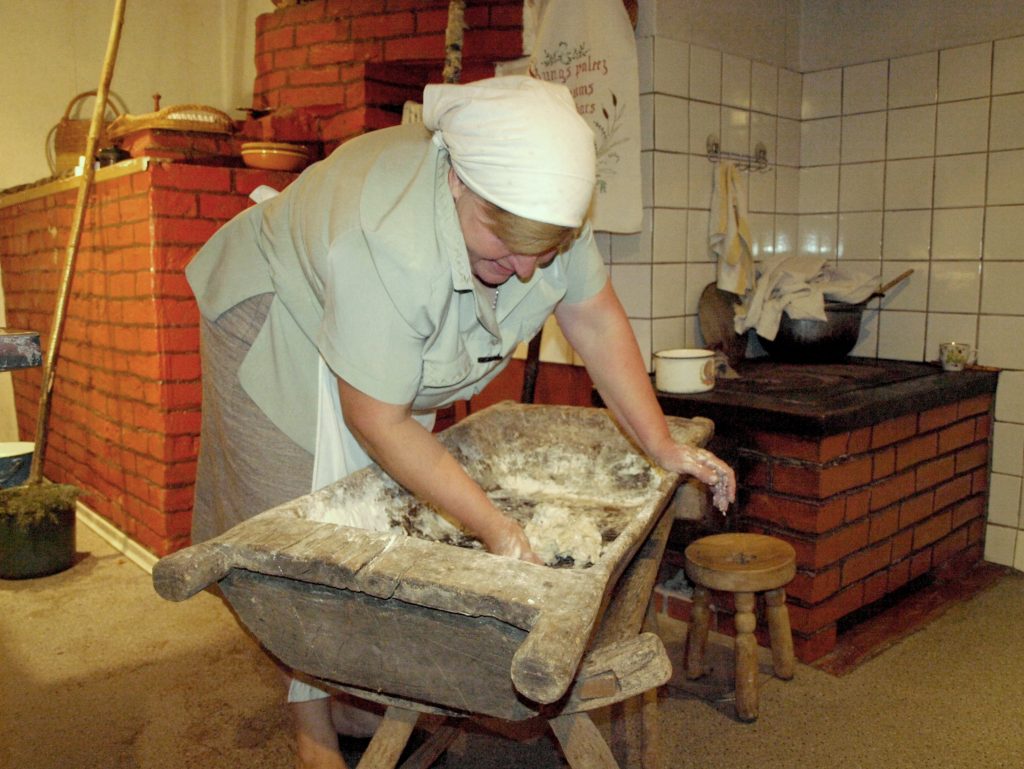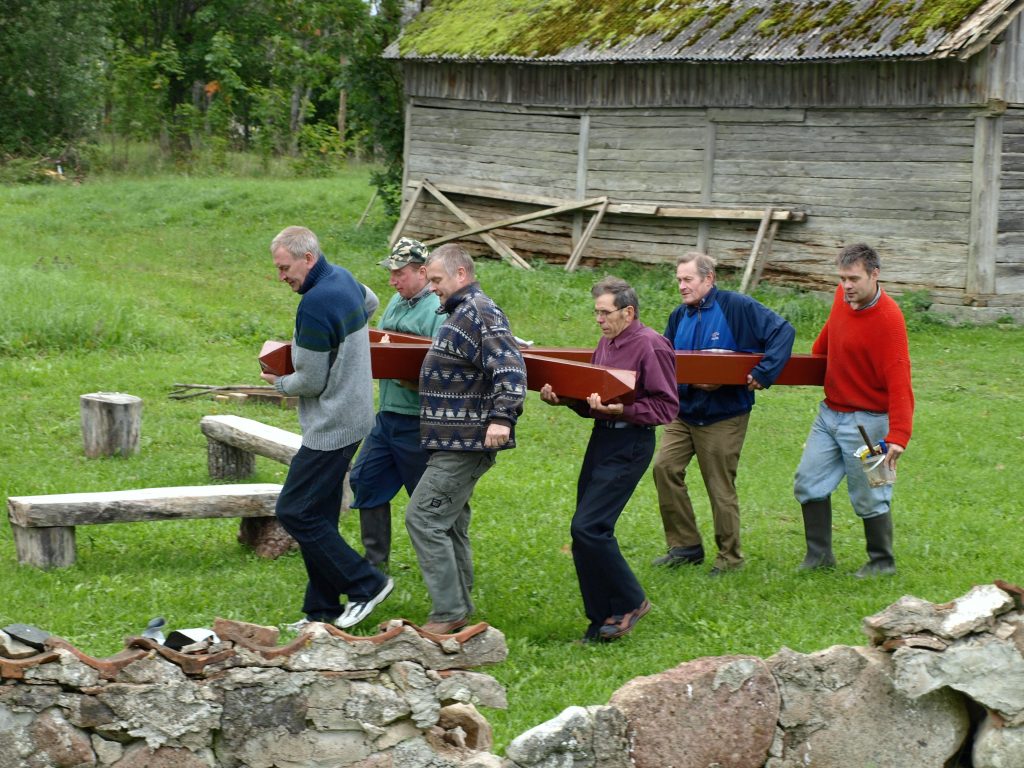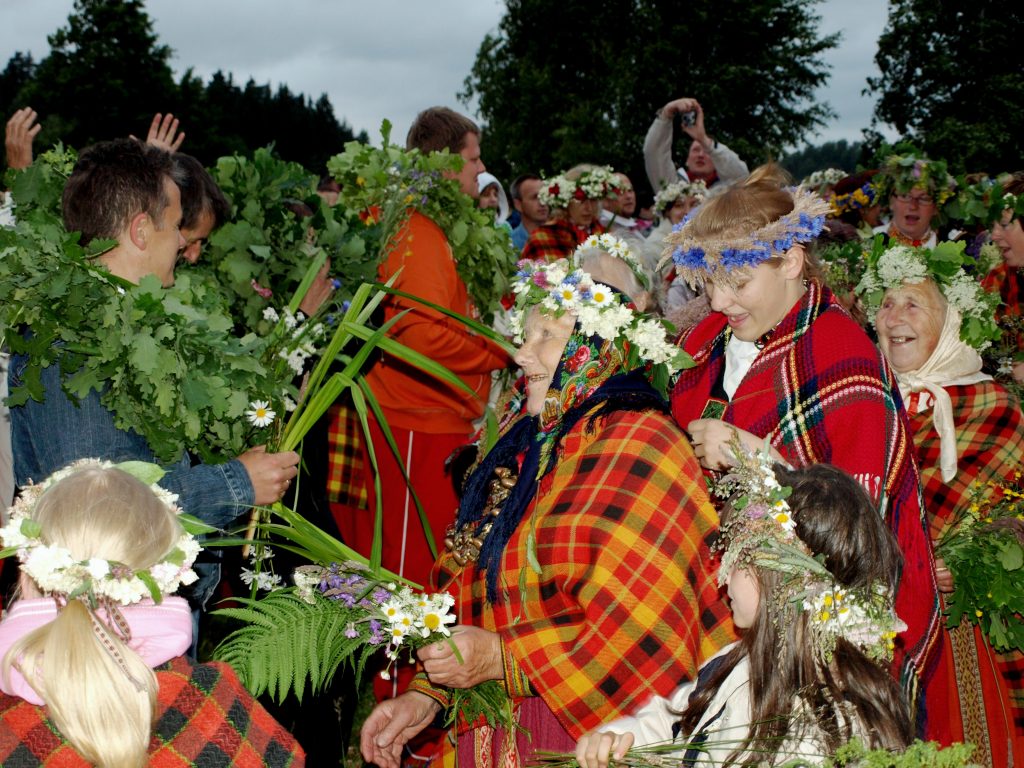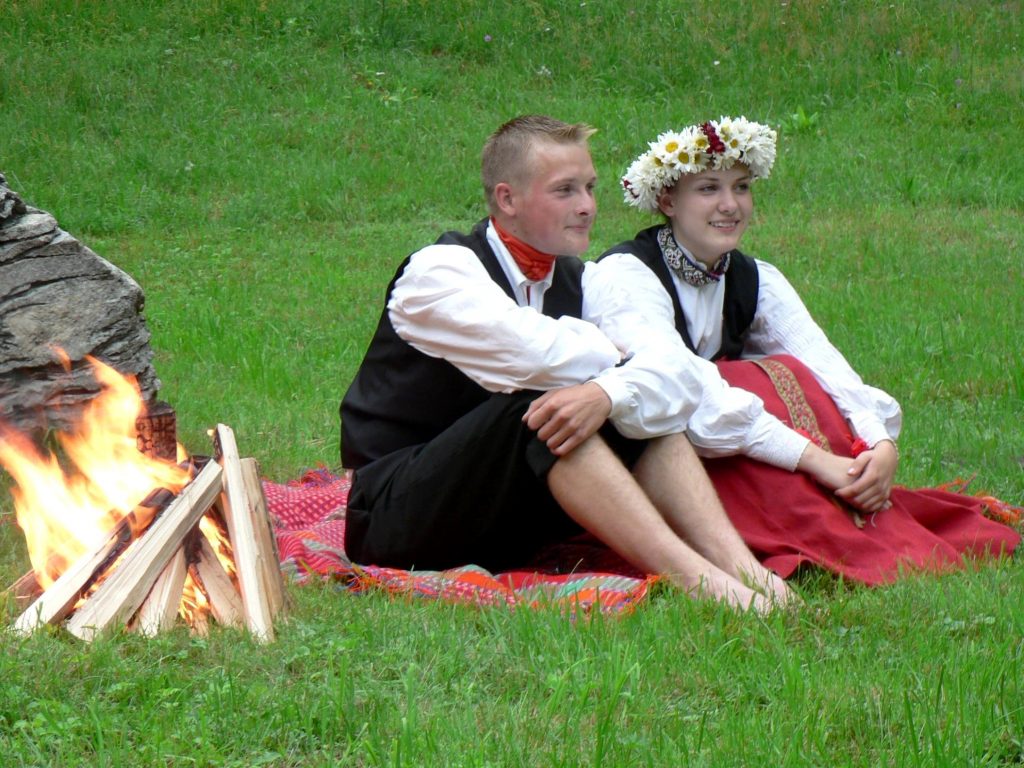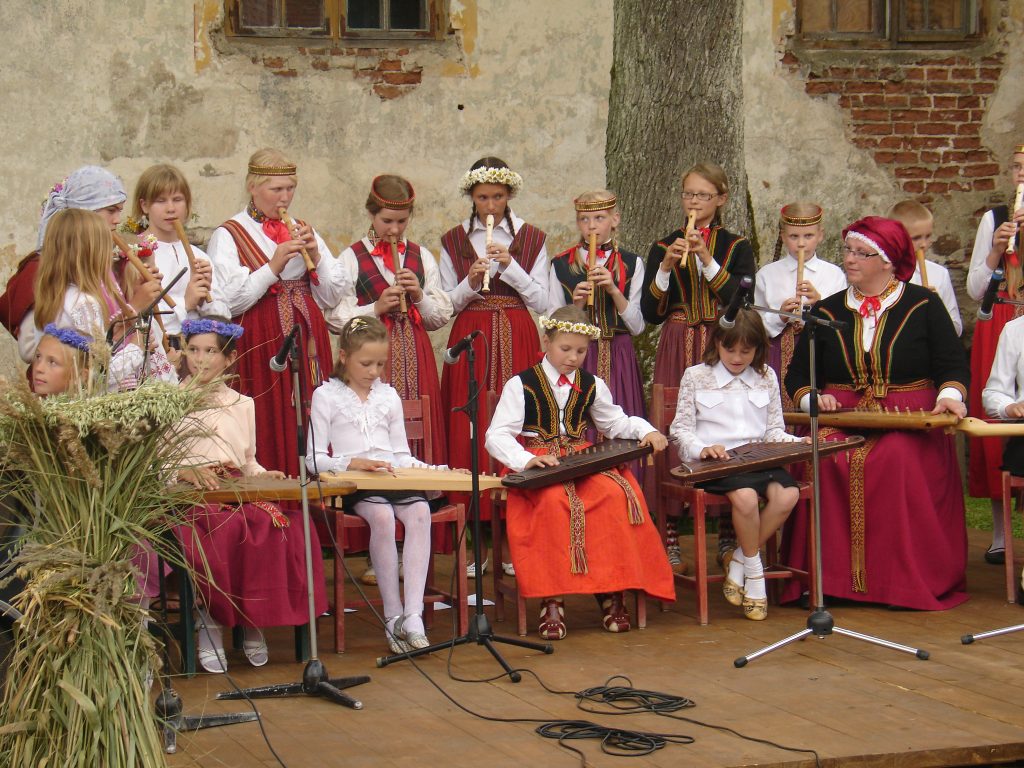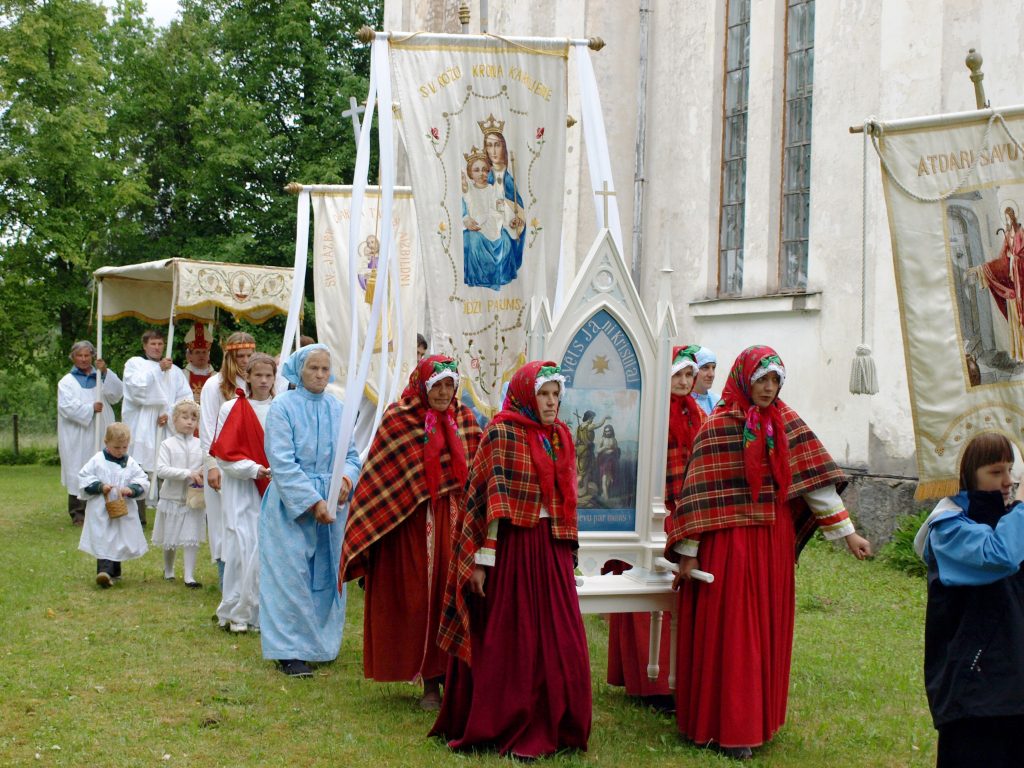Author:
Grigorijs Rozentāls
Oral traditions and their expressions, including language as a vehicle of intangible cultural heritage
Social practices, rituals and festive events
Music/performing arts
Traditional kitchen
Knowledge and practices concerning nature and the universe
Title
Suiti Cultural Space
The Suiti is a small Catholic Community in Lutheric Kurzeme. Due to religious differences, the Suiti have developed a particular sense of identity that has helped create a unique cultural heritage and brought it through the centuries. In the current day, this cultural heritage is a mixture of ancient cultural elements, some of which originate even in the pre-Christian period, and religious traditions that have entered the environment of modern life. Today the Suiti culture space occupies a large area of 400 square kilometers. Around 2,000 people with Suiti origins live there, which is significantly less than at the beginning of the 20th century (10,000).
Significance in community life
Important bastions of Suiti cultural heritage are the ancient families and homesteads. It is precisely here that a large part of Suiti's cultural heritage inheritance is still passed on. The ancient Suiti region homesteads are often repositories of old clothing, furniture, and other household items. People who live in these houses see the value of these items not so much through their antiquity but through their connection to previous generations of their family. Precisely in these ancestral homes, various ancient traditions are observed simply because previous generations have done so. Despite the aging of the Suiti community, a large number of people still actively want to participate in preserving the local culture. Today, three ethnographic ensembles and two adult dance collectives operate in the region.
School-age children have two ethnographic ensembles and three dance collectives, where they can get involved in the preservation of the Suiti culture at an early age. The Alsunga Suiti wives are among the 7 most requested ethnographic ensembles in Latvia, and, on average, they perform around 80 times a year.
In 2009, the Suiti cultural space was included in UNESCO's Emergency Intangible Cultural Heritage List:
https://ich.unesco.org/en/USL/suiti-Cultural-Space-00314
See the text of the application in the “Textual Resources” section.
Activities
• Oral tradition and expressions, including language as an intangible cultural heritage;
• Stage art;
• Social customs, rituals, and festivals;
• Knowledge and skills related to nature and the universe;
• Traditional crafts.
Passing on and transferring skills
The Suiti Community ethnographic ensembles, dance collectives, and recently even children and youth folklore groups and collectives, have been a long-term attempt to preserve and transmit certain elements of the Suiti intangible cultural heritage from generation to generation. However, the targeted activities by the Suiti Community focused on the identification, exploration, knowledge, and skills of this heritage, particularly through formal and non-formal education and the attraction of intangible cultural heritage experts, began with the founding of the culture center “Suiti” in 2001. To promote the Suiti culture in Latvia, the International Bourdon Festival has been organized every three years (in 2007, 2010) since 2004. It brings together practitioners of the Suiti tradition and vocal and instrumental drone traditions from other regions of Latvia and countries around the world. Alongside concerts, workshops are held featuring demonstrations of Suiti and other cultural traditions, as well as seminars on the challenges associated with inheriting and transmitting the knowledge and skills related to intangible cultural heritage.
History
Suiti is a small, compact Latvian ethnoconfessional (Catholic) group. As a result of religious self-isolation over 375 years, the Suiti community has created, accumulated, and largely preserved their unique intangible cultural heritage to the current day, part of which is rooted even in the pre-Christian period. This heritage brings not only the influence of ancient Kurdish culture but has also been enriched by the cultures of the close-to-lost Livonian, Polish, and German peoples who have lived there for centuries. The boundaries of the historic Suiti municipality are still largely similar to those of the Schverin family in the 17th century. At that time, the owner of the land decided to become a Catholic and also to convert his peasants, which created this conservative environment, in which, like a living museum, a unique intangible cultural heritage has been preserved to this day.
In order to maintain their identity, the Suiti have developed a self-insulation policy. Marriage to Lutherans was considered a sin, so the whole of the Suiti community shares a familial bond to this day. If two Suiti begin to discuss their ancestry, there is a great probability that they will quickly find shared relatives. Today, the border between Catholics and Protestants is an invisible line in the municipality that divides the local community into two parts. And people still notice which side of the border a person belongs to. This might be why this small Suiti community has been able to survive the pressure of assimilation for so long, and has been able to create and largely preserve their unique cultural heritage to the current day, which, according to us, can give a visible contribution to the intangible cultural heritage of Latvia, Europe, and the rest of the world.
Masters
Agencies and institutions
Unions:
• Ethnical Culture Centre “Suiti”;
• “Suitu kultūras mantojums”;
• “Suitu amatnieki”;
• “Alsungas keramika”;
• “Suitunovads”;
• “Ziedupīte”;
• “Maģie suiti”;
• “Spanga”;
• Alsunga Smart Village.
Companies:
• “Bērziņi”;
• “Bumbuļmaize”;
• “Suitu rausītis”;
• “Ceiņi”;
• “Anitas rauši”;
• The Catering Company “Spēlmaņu krogs”.
Local authorities and other institutions:
• Alsunga Tourism Information and Historical Heritage Centre;
• PII “Miķelītis” – Primary school educational institution;
• Alsunga Primary School;
• Alsunga Music and Art School;
• Alsunga Cultural House;
• Alsunga Library;
• Gudenieki Library;
• Basi library;
• Jūrkalne Library;
• Suiti communities – Alsunga, Jūrkalne, Gudenieki Roman Catholic communities.
Consolidation
Research and documentation:
• The exhibition “Vētru muzejs” in Jūrkalne and “Suitu godi” in Basi have been created in the Suiti cultural space;
• Published book–photo album “Suitu zemes ļaudis”, as well as published books in the book cycle “Suitu novada mantojums” – “Suit drāns”, “Daņči”, “Suitu burdons”, “Savējie sapratīs”, “Vietvārdi”, “Suit stāst”, “Suit villdrāns”;
• Published The children’s books for preschool children – “Suiti”, “Anniņa un Miķelītis apceļo suitu zemi”;
• Published the booklet “Suitu papīra lelles”, issued booklet “Suitu stila grāmata”, book “Suitu kāzu tērps un tā valkāšanas tradīcijas 19. gs.”
Practice, transmission, education:
• Traditionally, every year, a summer camp called “Suitu tradīciju skoliņa” is organized for children of primary school age. Its aim is to teach Suiti traditions and explore their history.
Several projects have been implemented:
• EST–LAT cross-border cooperation programme “UNESCO-Tourism”. The project's objective was to develop and promote cultural tourism in UNESCO's recognised regions “UNESCO tourism” in cooperation with Livonians in Latvia, Seta and Kihnu Communities in Estonia;
• The objectives of the EU project “Suitu jaunieši var!” are to promote the preservation and popularity of European intangible cultural heritage, particularly UNESCO-recognized values, by implementing educational activities for the communities inheriting intangible cultural heritage;
• Project of the European Commission's Erasmus+ programme “Network of UNESCO Cultural Spaces”. With the aim of sharing methods, approaches, and best practice examples among partner organizations and countries, the project seeks to provide participants with a comprehensive overview of the situation regarding intangible cultural heritage in each country;
• The financial support of the EU program “Erasmus+” has enabled the initiation of international collaboration projects such as the “Network of UNESCO Cultural Spaces” and “One Voice.”
Organised:
• 6th International Bourdon Festival;
• Latvian piper gatherings;
• Bourdon Singing Festival;
• Suiti National Costume Parade;
• A conference on cultural diversity in Kurzeme;
• Exhibitions and displays related to the intangible cultural heritage traditions and expressions;
• Regular traditions-based training and masters.
Promotion of visibility:
• The Suiti amateur craftsmanship collectives and representatives participated in the XXVI Nationwide Latvian Song and XVI Dance Festival. In 2018 the ethnographic performance “Suiti wedding” was renewed;
• The website www.suiti.lv was created. A Suiti Cultural Space logo was also created;
• Craftsmen begin using the logo “Tapis suitos”.
Companies and creative industries:
• “Smart village” formed in Alsunga;
• A weekly “Suiti market” was launched in Alsunga.
Infrastructure:
• The Alsunga Tourism Information and Historical Heritage Center has been established, creating spaces for artisans and unions. Creative workshops, such as “Suitu ķēķis” and “Austuve” have been created and improved. Additionally, a “Suiti Heritage Repository” has been established to preserve and showcase the Suiti cultural heritage;
• A open-air Concert Hall “Vējturu nams” was created in Jūrkalne;
• Several repairs to Alsungas Castle have been completed;
• The St. Joseph's Catholic Church buildings in Jūrkalne have been renewed and illuminated, with video surveillance, electronic attendance records, and an informative stand on church history and the Suiti cultural space.
The participation of the Suiti community, groups, and individuals in the preservation of their cultural space is reflected in the establishment of new members and non-governmental organisations in order to defend the social, political, and economic interests of the Suiti community, as well as to promote cooperation between the local population and participation of young people. Although the activities of non-governmental organisations are mainly based on the initiative of just a few individuals, they have successfully raised funds from local and national governments, and the European Union, through the implementation of projects that benefit the Community. The activities of local entrepreneurs, artisans, and home producers also contribute to community development. Of particular importance is their involvement in the activities of amateur art collectives, especially those related to Suiti traditions. In view of the constraints caused by the COVID-19 pandemic and the changing epidemiological situation in Latvia, the activities of amateur artists have been very limited. The number of participants has remained stable in the Alsunga ethnographic ensemble “Suitu sievas” (founded in 1955), with 17 active members, and in the creative workshop “Austuve” (established in 2008), with a team of 12. In several collectives, prior to the onset of the COVID-19 pandemic in 2020, an increase in the number of participants was observed. The number of participants has grown in the Alsunga folklore group “Suitu dūdenieki” (from 7 to 11 members since 2014), the Alsunga folklore group “Suitu vīri” (from 10 to 13 members since 2013), and periodic growth has been observed in the Alsunga Cultural Center's chapel ensemble “Suitu muzikanti” (from 5 to 6 – 7 members since 2010) and the Gudenieki ethnographic ensemble “Gudenieku suiti” (from 12 to 14 – 16 members since 1965). Additionally, in 2021, the handicraft studio “Kangas” was established.
The updated plan for the preservation of the Suiti cultural space for the next four years has been developed based on the activity plan created by EKC “Suiti”. In addition to that, discussions on plan-related issues took place on October 7, 2021, where representatives from Suiti organizations such as the “Suiti Parliament” and “Suiti Cultural Heritage”, as well as representatives from the Ministry of Culture, Latvian National Centre for Culture, UNESCO National Commission of Latvia, and the UNESCO Intangible Cultural Heritage Policy and Law Department of the Latvian Academy of Culture, gathered to discuss the plan's approval and sign a memorandum of mutual cooperation. Each participating party expressed its commitment to collaborate within the limits of its competence and resources to preserve the Suiti cultural space. In October 2021, the Suiti community conducted a survey in collaboration with the Latvian National Centre for Culture to gather the community's current opinions on the most important goals for preserving the Suiti cultural space in the upcoming period. Alongside the development of the updated preservation plan, the preparation of state and municipal planning documents took place, ensuring opportunities for public participation. The active involvement of representatives from the Suiti community has been implemented in the exploration of opinions during the planning of municipal cultural development programs.
Continuation/development
The updated preservation plan of the Suiti cultural space (2022–2025) is a continuation of the previous preservation plan and is based on the draft plan drawn up by the EKC “Suiti”. The expected results and activities cover:
Documentation and research. It is intended:
• To continue to identify and explore the cultural heritage of the Suiti community, including the sacred heritage;
• To ensure the digital accessibility of heritage;
• To issue research publications, to create audiovisual materials for the preservation and promotion of heritage;
• To document cultural developments and to establish a Suiti museum – municipality research centre.
Practice and transmission:
• The traditional and religious festivals of the Suiti will continue to be celebrated;
• Festivals will be organized;
• Community church activities and the inheritance of Christian traditions will get promoted;
• Collaboration and exchange of experiences with other communities or bearers of traditions in Latvia and internationally will be established;
• A Suiti ethnographic homestead will be created to preserve evidence of the traditional way of life of the Suiti in rural areas;
• Support will be provided for the activities of amateur art collectives.
Education:
• The plan is to continue introducing children to Suiti traditions at the Alsunga preschool institution “Miķelītis”;
• In Alsunga Elementary School, the provision of “Suiti District Education” will be continued;
• Alsunga Music and Art School will ensure the mastery of traditional musical instruments and the acquisition of traditional visual expression methods specific to the Suiti;
• Existing creative workshops will be maintained, and new ones will be established to promote informal and lifelong learning.
Companies and infrastructure. There are plans to:
• Promote Suiti craftsmanship and homemade products;
• Develop cultural tourism based on Suiti traditions and skills;
• Develop digital infrastructure;
• Continue the preservation, restoration, and maintenance of Suiti churches, monuments, significant objects, and historical artifacts, restore Alsunga Castle;
• Continue the restoration of road infrastructure, and preserve the characteristic cultural landscape.
Support for the implementation of the Plan is linked to national policy planning documents:
• Guidelines for Cultural Policy (2021–2027);
• Plan for the Preservation and Development of Intangible Cultural Heritage (2021–2027);
• A policy planning document will be developed to implement the Latvian Historical Lands Law (2021).
Precise calculations for the funding required to achieve the Renewed Preservation Plan for the Suiti Cultural Space objectives for the period 2022-2025 have not been made. These calculations are typically prepared within the framework of specific project development. However, there is an indication of ongoing financial support planned to be provided in the coming years for the continuous preservation processes of the Suiti cultural space or for the implementation of specific projects.
• State support / planned support in the form of annual subsidies includes – Cultural education (for the activities of Alsunga Music and Art School) – 57,450 EUR Promotion of folklore groups and ethnographic ensembles – 3,645 EUR NGO projects – 15,000 EUR The annual support amounts to 76,095 EUR, and for the four-year period, it totals 304,380 EUR, with a potential gradual increase in funding. In addition, there are expected regular project competitions from the State Culture Capital Foundation, support for the activities of non-governmental organizations, and the continuation of the 2021 program of the Foundation for the Preservation of Intangible Cultural Heritage elements included in the national list;
• The Ministry of Culture has allocated a budget of 97,100 EUR annually from 2022 to 2024 for the Latvian Historical Lands. The Ministry of Environmental Protection and Regional Development planned a total funding of 1,118,600 EUR in 2021 for the construction of road sections (Adze–Gudenieki–Ēdole and Vecais Suitu ceļš) within the Suiti cultural space;
• Local government support/planned to continue to ensure the remuneration of the Suiti folklore groups and managers of amateur arts and their activities. For the restoration works of Alsunga Castle, the municipality of Kuldīga has planned approximately 126,700 EURO in the budget for 2022. According to the Ventspils Municipality Investment Plan 2021–2027, it is planned to continue improving access to the Baltic Sea coastal area and the restoration of the historical Jūrkalne Library building;
• International funding / Non-governmental organizations of the Suiti community are implementing several international cooperation projects, which will also be implemented during the next reporting period, including financial support from European Union funds in local and international project competitions. Similarly, state and municipal institutions plan to attract additional external funding, including European Union funds, to implement investments for the development of the Suiti cultural space.
The Suiti cultural space encompasses cultural features characteristic of the Suiti community, including dialect, bourdon singing, playing of bagpipes and other traditional instruments, as well as the craftsmanship involved in making those musical instruments. It also includes skills such as weaving, making and wearing traditional folk costumes for festivities, celebrating shared festivals, culinary heritage, and Catholicism. Although the role of the church in the community has diminished, and currently less than a third of the surveyed community members attend church services or are active in church congregations, Catholicism is still recognized as a pillar of the Suiti cultural identity. The Suiti community has a strong sense of belonging to their cultural space, and this is significant not only for the actively involved part of the community in cultural events, including members of ethnographic ensembles, folklore groups, dance collectives, various craft workshops, amateur theaters, and other groups representing different generations, or for the part of the community actively engaged in the activities of local non-governmental organizations, but also for a wider population.
Suiti identity serves as the foundation for taking pride in one's culture and belonging to it, as well as being knowledgeable about one's own history. Alongside the cultural functions of the Suiti cultural space, such as preserving cultural traditions, knowledge, and skills, educating children and youth, and shaping identity awareness, there is also a significant social function to serves as a resource for sustainable community development and internal cooperation to achieve specific goals set by the community. Strengthening cooperation does not exclude diversity of opinions, which can be observed within the community in managing its cultural heritage and in issues related to community and territorial development.
Personal involvement of individuals is crucial in preserving the Suiti cultural space, particularly in the transmission of traditions.
Applicant
Society “Ethnic Cultural Centre “Suiti””
Image Gallery
Video
Text Materials
Publications
“Suitu identitāte” is a collection of articles edited by Janīna Kursīte and published by LU Akadēmiskais Apgāds in Riga, 2005. Page 175.
“Balandnieki” is a collection of sketches from the memories of Priest Pēteris Upenieks. It was published by Madris in Riga, 2005. Page 760.
“Dziesminiece Veronika Porziņģe” is a book written by Dace Nasteviča. It was published by Preses nams in Riga, 1999. Page 312.
“Gudenieku Singing traditions”, Skaidrite Daugule, Preses nams, Riga, 1994. Page 14.
“Suitu pūrs” is a book compiled by Ervins Vēveris. It was published by Latvijas Etnogrāfiskais brīvdabas muzejs in Riga, 1991. Page 160.
“Senās suitu kāzas un ķekatas” is a book edited by Professor P. Šmits and compiled by J. Šperliņš. It is part of the “Latviešu folkloras krātuve” published in Riga, 1937. Page 161.
“Latvju raksti” 1st volume, Alšvanga, M. Siliņš, Riga in 1931, Page 1-56.
"Novadu tērpi" Part II, Kuldīga, Ventspils, Alsunga, Elga Kivicka, and Adolfs Karnups, “Latvijas lauksaimniecības kamera”, Jelgava, 1938, Page 36.
“Latviešu tautas tērpi, raksti, izšūšana”, Maruta Grasmane, Rasa ABC, Riga, 2002.
“Latviešu tautas tērpi, II Kurzeme”, Zīle Bremze, Velta Rozenberga, Ilze Ziņģīte, published by Jana seta in Riga, 1997. Page 398.
“Kurzemes viduslaiku pilis”, G. Erdmanis, published by Zinatne in Riga, 1989. Page 160.
“Kurzemes baroka tēlniecība”, Elita Grosmane, published by Jumava in Riga, 2002. Page 288.




